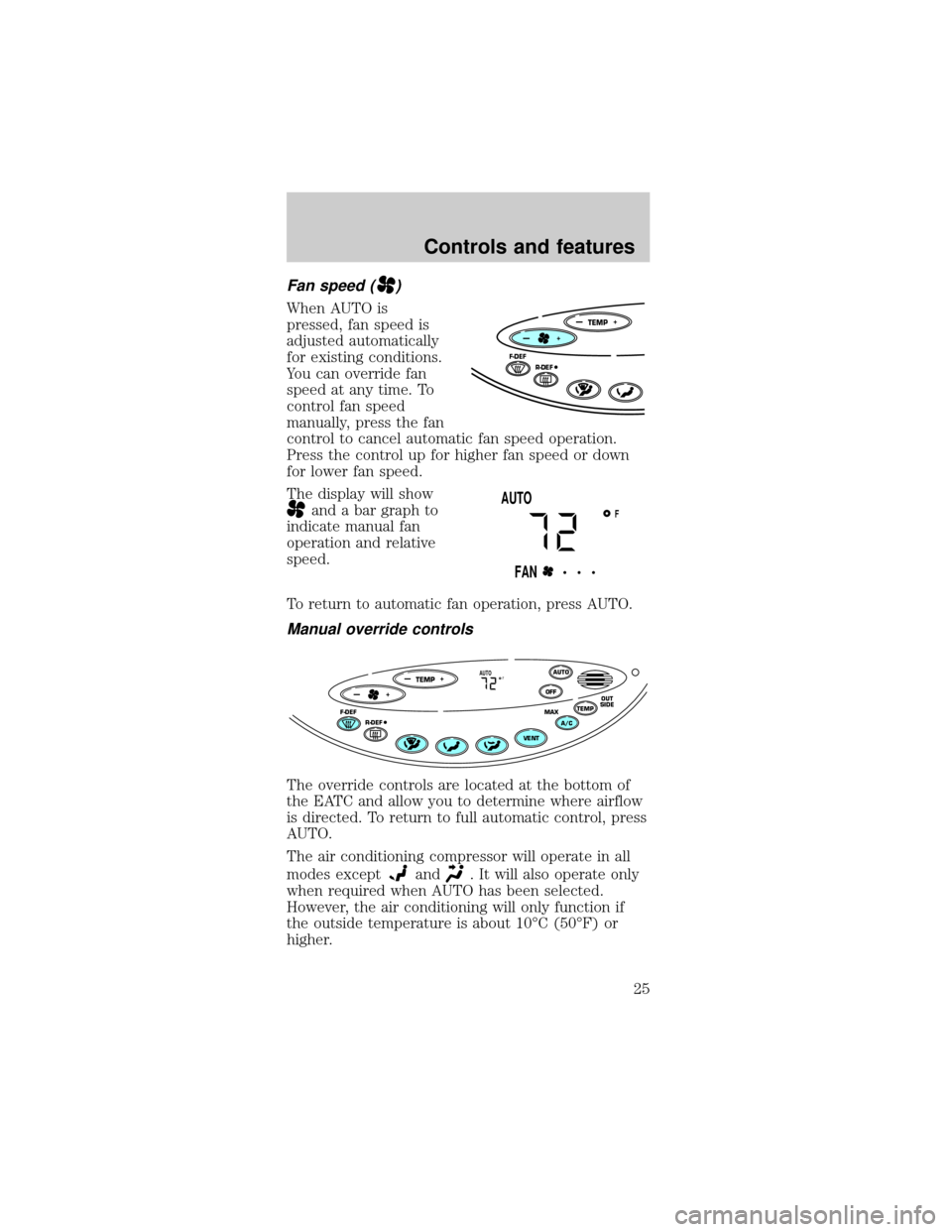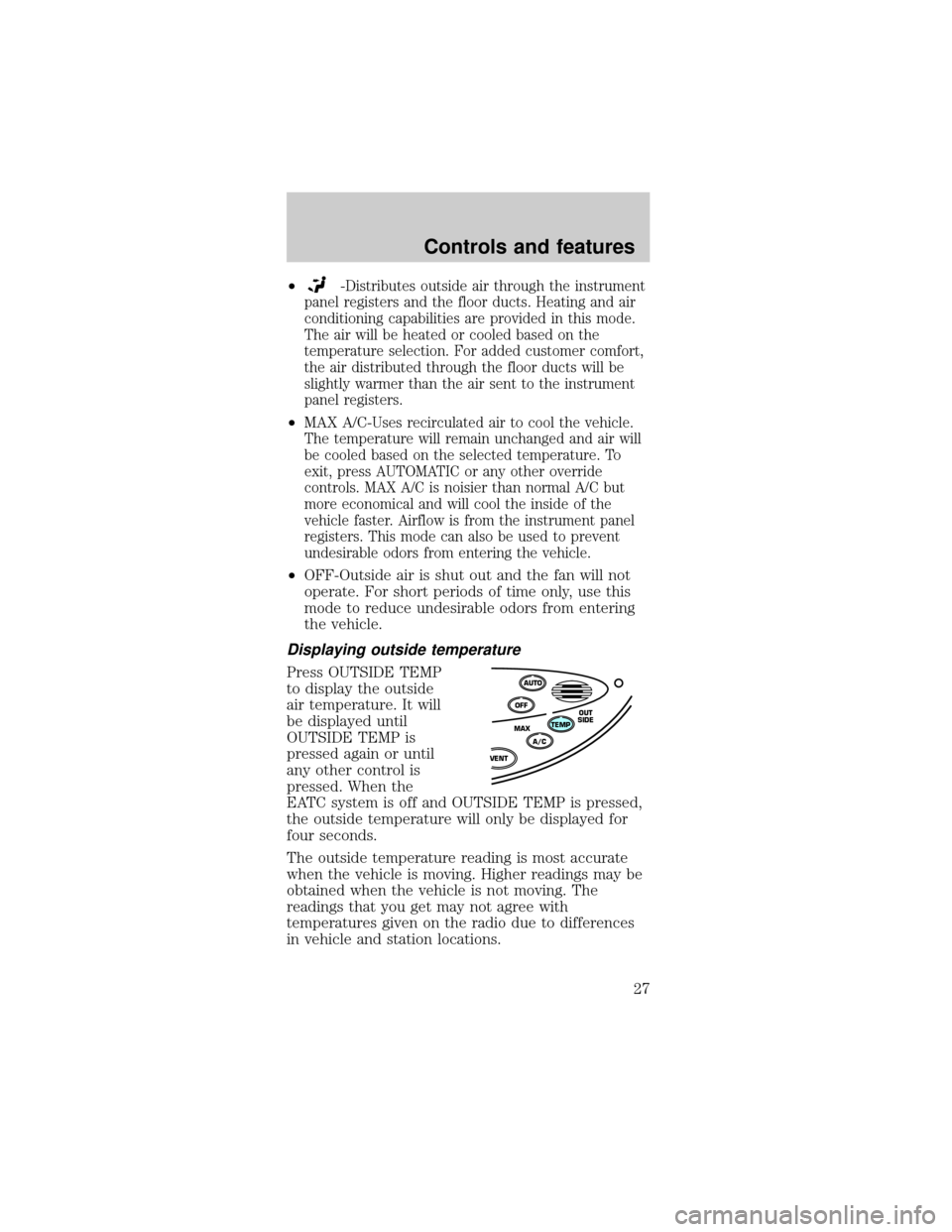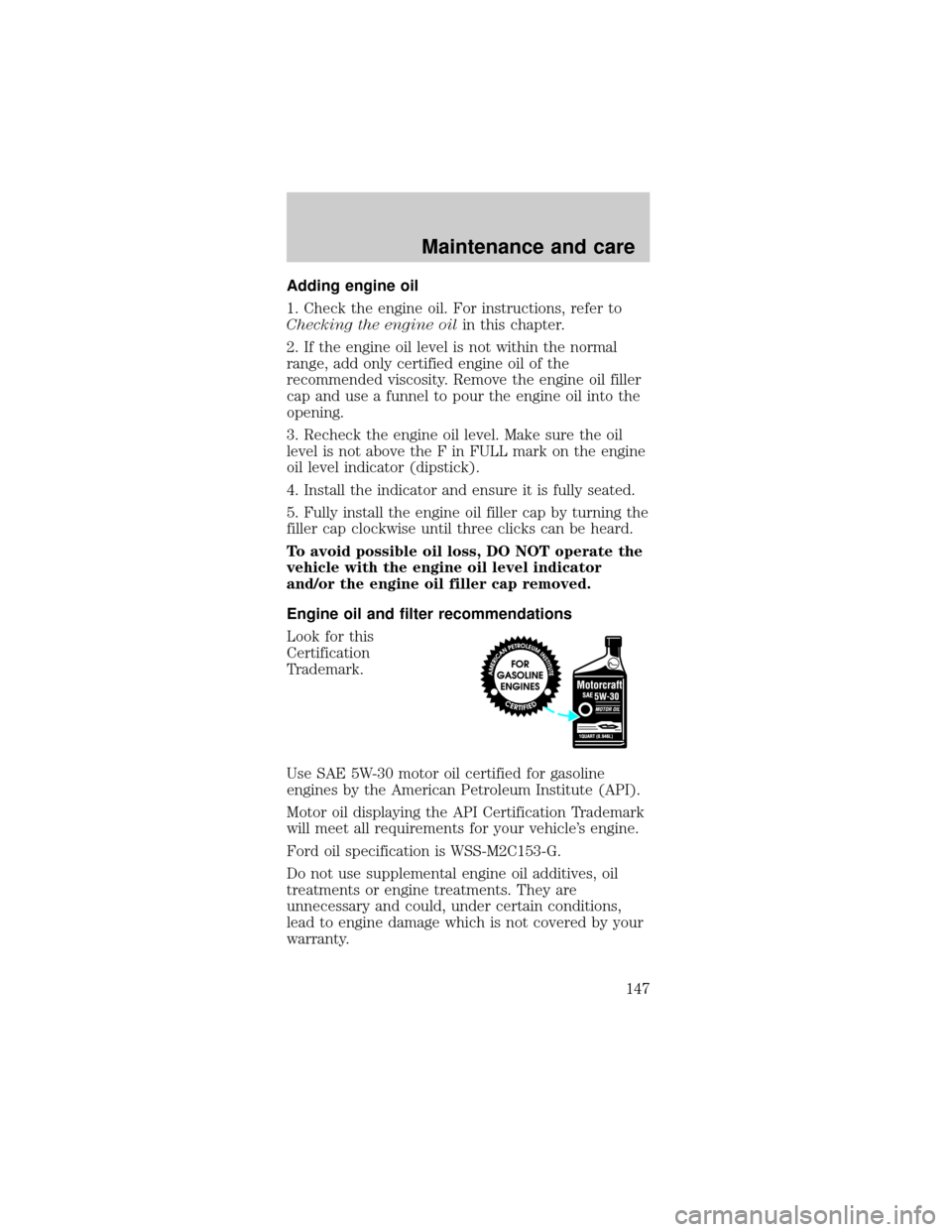1999 FORD TAURUS display
[x] Cancel search: displayPage 15 of 224

Fuel gauge
Displays approximately
how much fuel is in
the fuel tank (when
the key is in the ON
position). The fuel
gauge may vary slightly
when the vehicle is in
motion. The ignition
should be in the OFF
position while the vehicle is being refueled. When
the gauge first indicates empty, there is a small
amount of reserve fuel in the tank. When refueling
the vehicle from empty indication, the amount of
fuel that can be added will be less than the
advertised capacity due to the reserve fuel.
A minimum of six gallons must be added or removed
from the fuel tank in order for the gauge to
instantaneously update. If less than six gallons is the
change, the gauge will take between five to ten
minutes to update.
EF
Instrumentation
15
Page 23 of 224

Turning the EATC off
Press OFF. The
Outside Temperature
function will continue
to operate until the
ignition is turned off.
Automatic operation
Press AUTO and select the desired temperature.
The selected temperature and the word AUTO will
appear in the display window. The EATC system will
either heat or cool to achieve the selected
temperature. The system will automatically
determine fan speed, airflow location and if fresh
outside air or recirculated air is required. Fan speed
remains automatic unless the fan speed control is
pressed.
When in AUTO and weather conditions require heat,
air will be sent to the floor. However, if the engine is
not warm enough to provide heat, the fan will be at
a low speed and the air will be directed to the
windshield. In 3
1¤2minutes or less, the fan speed will
start to increase and the airflow location will change
to the floor area.
If unusual conditions exist (i.e.-window fogging,
etc.), the manual override controls allow you to
select airflow locations and the fan control allows
you to adjust fan speed as necessary.
Temperature selection
The display window
indicates the selected
temperature, function
(AUTO or one of the
override controls) and
manual control of fan
speed (
)if
automatic fan speed is not desired.
OFFAUTO
TEMPOUT
SIDE
A/C MAX
VENT
FAUTO
FAN• • •
Controls and features
23
Page 24 of 224

To control the
temperature, select any
temperature between
18ÉC (65ÉF) and 29ÉC
(85ÉF) by pressing the
temperature control.
For continuous maximum cooling, push the
temperature control until 16ÉC (60ÉF) is shown in
the display window. The EATC will continue
maximum cooling (disregarding the displayed
temperature) until a warmer temperature is selected
by pressing the temperature control.
For continuous maximum heating, push the
temperature control until 32ÉC (90ÉF) is shown in
the display window. The EATC will continue
maximum heating (disregarding the displayed
temperature) until a cooler temperature is selected
by pressing the temperature control.
Temperature conversion
Press MAX A/C and Fat the same time (until
the display changes) to switch between Fahrenheit
and Celsius.
TEMP
—+
F-DEF
R-DEF
—+
TEMP
—+OFFAUTO
TEMPOUT
SIDEA/C MAXF-DEF
R-DEF
VENT
—+AUTOC
Controls and features
24
Page 25 of 224

Fan speed ()
When AUTO is
pressed, fan speed is
adjusted automatically
for existing conditions.
You can override fan
speed at any time. To
control fan speed
manually, press the fan
control to cancel automatic fan speed operation.
Press the control up for higher fan speed or down
for lower fan speed.
The display will show
and a bar graph to
indicate manual fan
operation and relative
speed.
To return to automatic fan operation, press AUTO.
Manual override controls
The override controls are located at the bottom of
the EATC and allow you to determine where airflow
is directed. To return to full automatic control, press
AUTO.
The air conditioning compressor will operate in all
modes except
and. It will also operate only
when required when AUTO has been selected.
However, the air conditioning will only function if
the outside temperature is about 10ÉC (50ÉF) or
higher.
TEMP
—+
F-DEF
R-DEF
—+
FAUTO
FAN• • •
TEMP
—+OFFAUTO
TEMPOUT
SIDEA/C MAXF-DEF
R-DEF
VENT
—+AUTOF
Controls and features
25
Page 27 of 224

²-Distributes outside air through the instrument
panel registers and the floor ducts. Heating and air
conditioning capabilities are provided in this mode.
The air will be heated or cooled based on the
temperature selection. For added customer comfort,
the air distributed through the floor ducts will be
slightly warmer than the air sent to the instrument
panel registers.
²MAX A/C-Uses recirculated air to cool the vehicle.
The temperature will remain unchanged and air will
be cooled based on the selected temperature. To
exit, press AUTOMATIC or any other override
controls. MAX A/C is noisier than normal A/C but
more economical and will cool the inside of the
vehicle faster. Airflow is from the instrument panel
registers. This mode can also be used to prevent
undesirable odors from entering the vehicle.
²OFF-Outside air is shut out and the fan will not
operate. For short periods of time only, use this
mode to reduce undesirable odors from entering
the vehicle.
Displaying outside temperature
Press OUTSIDE TEMP
to display the outside
air temperature. It will
be displayed until
OUTSIDE TEMP is
pressed again or until
any other control is
pressed. When the
EATC system is off and OUTSIDE TEMP is pressed,
the outside temperature will only be displayed for
four seconds.
The outside temperature reading is most accurate
when the vehicle is moving. Higher readings may be
obtained when the vehicle is not moving. The
readings that you get may not agree with
temperatures given on the radio due to differences
in vehicle and station locations.
OFFAUTO
TEMPOUT
SIDE
A/C MAX
VENT
Controls and features
27
Page 44 of 224

²Do not leave tapes in the cassette player for a
long time when not being played.
Radio frequency information
The Federal Communications Commission (FCC)
and the Canadian Radio and Telecommunications
Commission(CRTC) establish the frequencies AM
and FM stations may use for their broadcasts.
Allowable frequencies are:
AM 530, 540±1600, 1610 kHz
FM 87.9, 88.1±107.1, 107.9 MHz
Not all frequencies are used in a given area.
Radio reception factors
Three factors can affect radio reception:
²Distance/strength.The further an FM signal
travels, the weaker it is. The listenable range of
the average FM station is approximately 40 km
(24 miles). This range can be affected by ªsignal
modulationº. Signal modulation is a process radio
stations use to increase their strength/volume
relative to other stations.
²Terrain.Hills, mountains and tall buildings
between your vehicle's antenna and the radio
station signal can cause FM reception problems.
Static can be caused on AM stations by power
lines, electric fences, traffic lights and
thunderstorms. Moving away from an interfering
structure (out of its ªshadowº) returns your
reception to normal.
²Station overload.Weak signals are sometimes
captured by stronger signals when you pass a
broadcast tower. A stronger signal may
temporarily overtake a weaker signal and play
while the weak station frequency is displayed.
The audio system automatically switches to single
channel reception if it will improve the reception of
a station normally received in stereo.
Controls and features
44
Page 147 of 224

Adding engine oil
1. Check the engine oil. For instructions, refer to
Checking the engine oilin this chapter.
2. If the engine oil level is not within the normal
range, add only certified engine oil of the
recommended viscosity. Remove the engine oil filler
cap and use a funnel to pour the engine oil into the
opening.
3. Recheck the engine oil level. Make sure the oil
level is not above the F in FULL mark on the engine
oil level indicator (dipstick).
4. Install the indicator and ensure it is fully seated.
5. Fully install the engine oil filler cap by turning the
filler cap clockwise until three clicks can be heard.
To avoid possible oil loss, DO NOT operate the
vehicle with the engine oil level indicator
and/or the engine oil filler cap removed.
Engine oil and filter recommendations
Look for this
Certification
Trademark.
Use SAE 5W-30 motor oil certified for gasoline
engines by the American Petroleum Institute (API).
Motor oil displaying the API Certification Trademark
will meet all requirements for your vehicle's engine.
Ford oil specification is WSS-M2C153-G.
Do not use supplemental engine oil additives, oil
treatments or engine treatments. They are
unnecessary and could, under certain conditions,
lead to engine damage which is not covered by your
warranty.
Maintenance and care
147